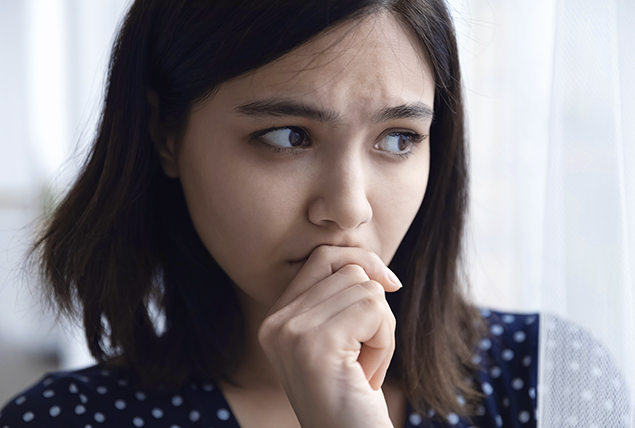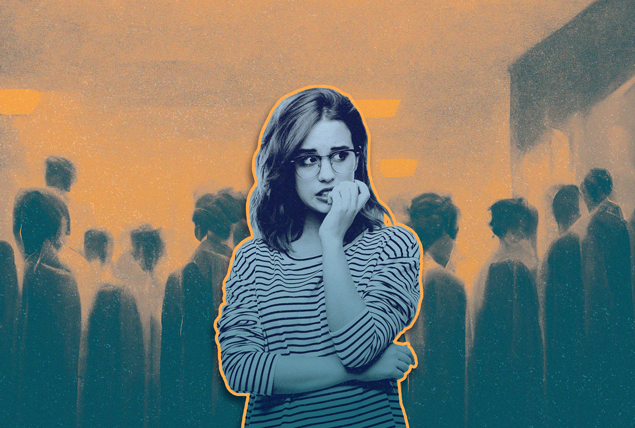I'm Anxious, but What Type of Anxiety Disorder Do I Have?

Key Points
- In combination, anxiety disorders affect 40 million adults each year—more than 15 percent of the U.S. population ages 18 and older.
- A few common symptoms serve as indicators of anxiety, including nervousness, panic or fear, overwhelming worry, increased heart rate, rapid breathing and difficulty sleeping. Physical symptoms include sweating, feeling weak or tired, and gastrointestinal problems.
- In adults and adolescents, nearly twice as many females suffer from an anxiety disorder than males.
Anxiety disorders are the most common form of mental illness in the United States, but several misconceptions and misunderstandings make living with anxiety even more difficult than it already is.
Most people have likely felt anxious at some point—perhaps due to a stressful situation or other life circumstances—but anxiety disorders differ in frequency, level of severity and overall effect on quality of life in a substantial way.
Knowing what, exactly, anxiety is and what it isn't remains the first step in learning how to manage it or perhaps even overcome it.
What are anxiety disorders?
"Everybody experiences anxious feelings from time to time," said Amy Marschall, Psy.D., a licensed psychologist and the founder of RMH Therapy in Sioux Falls, South Dakota. "Anxiety is adaptive. If you weren't capable of experiencing anxiety, that would be dangerous."
She has a ready example. Imagine a sabertooth tiger coming into a clearing and our ancestors who didn't experience anxiety trying to pet it. They probably didn't survive. The ones who got anxious ran away.
Her point is to illustrate that anxiety is not inherently bad. Historically, this has been quite beneficial to the continued survival of the human species. Even in our modern world, we wouldn't want to be incapable of feeling anxiety. A certain level of anxiety can become a detriment rather than a boon, however.
When is that? From a mental health standpoint, Marschall offers the following indications:
- When that anxiety crosses over the threshold of your brain and begins identifying danger in non-dangerous situations.
- When your brain cannot let go of the idea that you might be in danger right now.
- If the amount of anxiety you feel in response to a situation isn't proportionate.
"In these situations, it becomes clinical," she said.
The general idea behind anxiety disorders is that for a situation, you experience a disproportionate amount of anxiety. To be classified as a disorder, that level of anxiety has to negatively impact your quality of life.
Of course, anxiety disorders aren't a one-size-fits-all classification. There are, in fact, many conditions that fall under the larger "anxiety disorder" umbrella.
Types of anxiety disorders
Experts with the Anxiety & Depression Association of America (ADAA) identified several of the most common anxiety disorders experienced by adults. In combination, these disorders affect 40 million adults each year—more than 15 percent of the U.S. population ages 18 and older.
More specifically, their data showed that generalized anxiety disorder (GAD)—what most people typically think of when we use the blanket term "anxiety"—affects 6.8 million adults each year, just over 2.6 percent of the adult population, and affects women twice as much as it affects men.
Generalized anxiety disorder also frequently co-occurs with major depression, which likely contributes to the occasional confusion of the two conditions.
In addition to GAD, the ADAA identified panic disorder, obsessive-compulsive disorder (OCD), social anxiety disorder (SAD), post-traumatic stress disorder (PTSD) and specific phobias all as forms of anxiety disorders. Each has its own triggers, symptoms, side effects and treatments.
"Obsessive-compulsive type disorders are a separate chapter in the Diagnostic and Statistical Manual of Mental Disorders (DSM) from anxiety disorders, but you can, of course, have OCD with anxiety symptoms," Marschall said. "Chemically, there are similarities. Symptom-wise, there's a lot of overlap.
"But you have to remember that people aren't categories. We make the categories so we can have a general idea of what treatment could help."
This nuance exists across a wide array of mental health conditions. Unfortunately, this can lead to terms being used interchangeably when they are not the same thing.
Recommended
- Scheduling Sex Helps Me Overcome Anxiety and Get in the Mood: You're going to want to set a reminder for this.
- Agoraphobia and How It Relates to Panic Disorder: Are you just a homebody or is it becoming a full-blown phobia?
- Scream This Instead: Nicknames For Your Partner in the Bedroom: From 'lover' to 'daddy,' learn what they want to be called during sex.
Anxiety vs. stress vs. depression
Even among the different types of anxiety, a few common symptoms serve as indicators of anxiety. Typically, these include nervousness, panic or fear, overwhelming worry, increased heart rate, rapid breathing and difficulty sleeping. Physical symptoms include sweating, feeling weak or tired, and gastrointestinal problems.
Many of these symptoms can be found in a person under a great deal of stress; as a result, the two terms are often used to describe the same sensation. In truth, though, the line between stress and anxiety is a fine one. The differences boil down to what triggered the emotional response and how long it lasted.
Typically, stress is a more short-term response to an external trigger, such as an upcoming deadline on a project that's already behind schedule. Anxiety disorders, by definition, are long-term conditions characterized by internal triggers. That's not to say that situations can't make a person anxious.
To cite a common example, having to give a speech could cause you to feel anxious, but the feeling in this instance is rooted in personal fears about giving the speech. The speech itself does not pose a threat. Stress, on the other hand, is more often the result of some actual threat. Missing a deadline could result in the loss of a job, in which case the deadline itself and, by proxy, the employer pose a real threat to your livelihood.
Once the deadline passes, assuming it has been met, the stress is likely to pass, too. Perhaps the anxiety of giving a speech would also pass once the speech has been given, but it's likely to resurface the next time. It's also safe to assume anxiety will present itself in other situations as well, perhaps as performance anxiety in the bedroom, which could in turn lead to other conditions, such as erectile dysfunction (ED).
Depression also joins the conversation when people talk of anxiety and stress, albeit in a different way. It's not that depression and anxiety are used interchangeably. Rather, because depression and anxiety often co-occur, their symptoms, which also can overlap, may be misinterpreted as being the result of the other condition.
For example, a person's inability to sleep might be chalked up to anxiety when it is a symptom of their depression. In another case, an individual might feel that their inability to get an erection is due to their depression when they are actually feeling anxious about having sex.
Of course, these situations can also be the result of a combination of symptoms.
Facts, stats and studies
The National Institute of Mental Health (NIMH) conducted a series of studies regarding anxiety disorders in the U.S. The results were similar to those of the ADAA; however, the NIMH data was more comprehensive.
Some of the NIMH key findings include the following:
- An estimated 31 percent of adults experience an anxiety disorder of any type at some point.
- About 23 percent of adults with an anxiety disorder had a serious impairment, 33.7 percent had a moderate impairment and 43.5 percent experienced a mild impairment.
- Similarly, an estimated 31.9 percent of adolescents had an anxiety disorder.
- In adults and adolescents, nearly twice as many females suffer from an anxiety disorder than males.
While studies regarding anxiety often paint in broad strokes, these findings do offer a general understanding of who is affected by anxiety, with two notable takeaways. One, anxiety affects more women than men. Two, a significant portion of the U.S. population suffers from an anxiety disorder at any given moment.
Despite this, a fair amount of stigma surrounds anxiety, particularly the treatment of the condition.
Given its prevalence, most people probably know at least one person who suffers from an anxiety disorder. This is not something to be ashamed of. If you or a loved one may have an anxiety disorder, you should speak with a healthcare professional who will be able to provide a diagnosis and treatment and potentially guide you to a specialist.


















